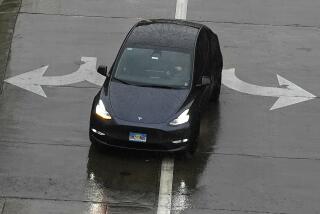Saturday Drive: 2012 Tesla Model S
The car: 2013 Tesla Model S
The power: 362 horsepower and 325 pound-feet of torque coming from an 85 kWh battery and a rear-mounted, liquid-cooled, AC induction motor routing power to the rear wheels.
The speed: 0-60 mph in 5.6 seconds
The bragging rights: World’s first all-electric luxury sedan (though it’s technically a hatchback).
The price: Between $57,400 and $95,400 without options and before any federal or state tax credits. As tested: $81,150 (estimated).
The details: The first of the Tesla Model S vehicles are finally starting to roll into owners’ hands after several years of gestation, customer deposits and partnerships with the likes of Toyota and Mercedes-Benz. This is the first vehicle the Silicon Valley company has built from the ground up; its first car was the all-electric, two-seat Roadster that was loosely based on the Lotus Elise and is no longer in production. The company recently announced a third vehicle, the Model X crossover, which is expected to land in customer hands in 2014. Tesla says it expects to build 5,000 Model S cars this year and an ambitious 20,000 in 2013.
The Model S is an all-electric vehicle powered by one of three battery choices. A base model with a 40 kWh battery and a projected range of 160 miles will be available this winter for $57,400. It’s expected to hit 0-60 mph in 6.5 seconds. Its battery has an eight-year, 100,000-mile warranty, and the rest of the car (as is the case with all Model S vehicles) has a four-year, 50,000-mile warranty.
An additional $10,000 will get you an estimated 230-mile range and a 5.9-second 0-60 time from a 60 kWh battery. It should be available this fall and the battery’s warranty jumps to 125,000 miles. Horsepower and torque figures for this and the base model have yet to be released.
Finally, for $77,400, you can the model we tested. It comes with an 85 kWh battery pack good for an EPA-estimated 265 miles (Tesla says it will get 300 miles on one charge) and a 5.6-second 0-60 time. Power comes in at 362 horses and 325 pound-feet of torque, and there’s unlimited mileage on the battery’s warranty.
If you have $15,000 more lying around (and frankly, who doesn’t these days?), Tesla will grant you a performance variant of this top-end model. It uses the same battery but swaps in a more powerful inverter, netting in the process 416 horsepower and 443 pound-feet of torque and a scant acceleration time of 4.4 seconds. This model also comes standard with the Tech package (HD backup camera, LED foglights, turn-by-turn navigation, power liftgate and Xenon lights) that runs $3,750 on other models, and an upgraded sound system and an active air suspension.
(Note that all the above availability dates are for customers who have already put down a fully refundable $5,000 deposit. Tesla says if you were to walk into a showroom today and order a Model S, you could expect to get it in your grubby little paws next May. Also, all prices mentioned do not include any state or federal tax incentives or rebates. And no, we’re not going to fall into the rabbit hole of how many of your tax dollars did or did not go to Tesla and why that is or is not a complete waste of your money. We’re here to drive, people, not to debate.)
All versions come with a mobile charging unit that can use a 110v, 240v or public charging station, which Tesla says can recharge fully the batteries in six to 10 hours. The company says a home charging station will run buyers about $1,200 and will recharge the batteries from empty to full in less than four hours. Finally, Tesla says it is working to build public “supercharging” stations along major interstates where it has a high density of customers. The company says these outfits will give owners a 50% charge in 30 minutes, though this method isn’t recommended for regular use since it affects the long-term storage capacity of the batteries.
The Model S is pegged as a mid-size luxury car, in line with something like a BMW 5-Series, and its size backs this up. Five adults fit comfortably inside, with the added benefit of a flat floor in the back seats so the middle passenger has plenty of legroom. A pair of rear-facing kid seats are a $1,500 option for the car’s trunk (remember, it’s a hatcback, so your precious cargo has a view out the back. And air to breath). Because the Model S is electric, it also has the benefit of a second, smaller trunk in the front of the car (where most of our gas-burning hogs keep their engines), which Tesla adorably calls the Frunk.
But the most notable feature of the car’s interior is its 17-inch touchscreen mounted in the dashboard. This is standard on all versions and controls nearly all of the car’s systems, including the audio system, climate control, navigation and basic functions like headlights and steering settings. But buyers beware; though all models use Google Maps as the navigation system, it relies on a data connection through a cellular network; if you drive out of range, the maps are essentially useless. Only by adding the $3,750 Tech package do you get the turn-by-turn service.
The drive: Unfortunately, Tesla only allowed us a solid 20 minutes worth of drive time with the Model S, so consider the following a very brief take (we’ll have a full review, including a test of the car’s actual range, in the coming months).
The first thing evident when mashing the throttle on our 85 kWh test car was its neck-snapping acceleration. Electric cars have all their possible torque available for the taking from a dead stop, so those 325 torques get to work immediately. This is despite the Model S weighing in at a not-insignificant 4,647 pounds (roughly that of a BMW 7-Series).
The car’s acceleration is smooth and linear, and eerily quiet save for the faint high-pitched whine that is an electric vehicle’s trademark. This extra silence makes more apparent the wind noise seeping through the frameless doors.
Throughout our drive, the Model S felt stable and planted, aided by a low center of gravity (the batteries are below the passengers) and a near 50-50 weight balance. The car’s heft is noticeable around fast turns but it’s more predictable and easily controlled because of how the weight is centered. The steering has a nice, smooth feel to it, and drivers can adjust between Comfort, Normal and Sport. Meanwhile, the suspension is nicely tuned and plenty comfortable.
Inside, the touchscreen is a gem of clarity and functionality (a screen the size of Lake Elsinore makes this easier). Drivers can easily split the display between, say, navigation and audio, or use the entire screen for navigation, while controls for the climate stay fixed at the bottom of the screen. The entire display responds well to touch commands, and Tesla wisely avoided falling into the trap of hyper-styled aesthetics at the cost of function that plagues the Fisker Karma.
Though I always prefer tangible buttons, it’s understandable that Tesla used a software-based system like this. For one, the cost of designing and manufacturing a dashboard full of buttons can be prohibitively expensive when you’re a company the size of Tesla. Second, Tesla can just design and program one system to use in future vehicles like the forthcoming Model X. Finally, as Tesla develops updates for the systems features and programming, the company can offer simple downloadable updates remotely for cars already on the road.
The rest of the interior is well-designed, though a few ill-fitting pieces and gaps between panels serve as reminders that Porsche-quality interiors do not fall from the sky. This is perhaps the most conspicuous area where Tesla could improve the build quality of the Model S.
The biggest takeaway from my brief rendezvous the Model S is that it is a legitimate car that feels as solid and substantial as the gas-mongers it’s targeting (mid-size luxury sedans like the BMW 5-Series or the Audi A6). This bodes well for the future of Tesla. Building, designing and testing any car from the ground up is an immense undertaking for even the most established automakers, which have hundreds of millions of dollars at their disposal. That Tesla has managed to do so in less than half a decade is remarkable.
Yet in order for Tesla to truly succeed, it must be judged not as an upstart that is afforded a few mistakes because of its rookie status, but rather as an automaker whose products need to hold their own against the world’s largest and most established brands. Using a completely electric drivetrain means Tesla’s task with the Model S is even more daunting, as the customer base for such a vehicle is smaller than its competitors, if growing every day.
Through that lens, the Model S is a product that could use minor improvements to its interior and more thorough testing to determine its real-world range. But if you’re a car buyer already shopping in this strata of vehicles, this car is absolutely worth a very serious look.
Which is exactly what we’re going to do soon. Stay tuned.
More to Read
Inside the business of entertainment
The Wide Shot brings you news, analysis and insights on everything from streaming wars to production — and what it all means for the future.
You may occasionally receive promotional content from the Los Angeles Times.











